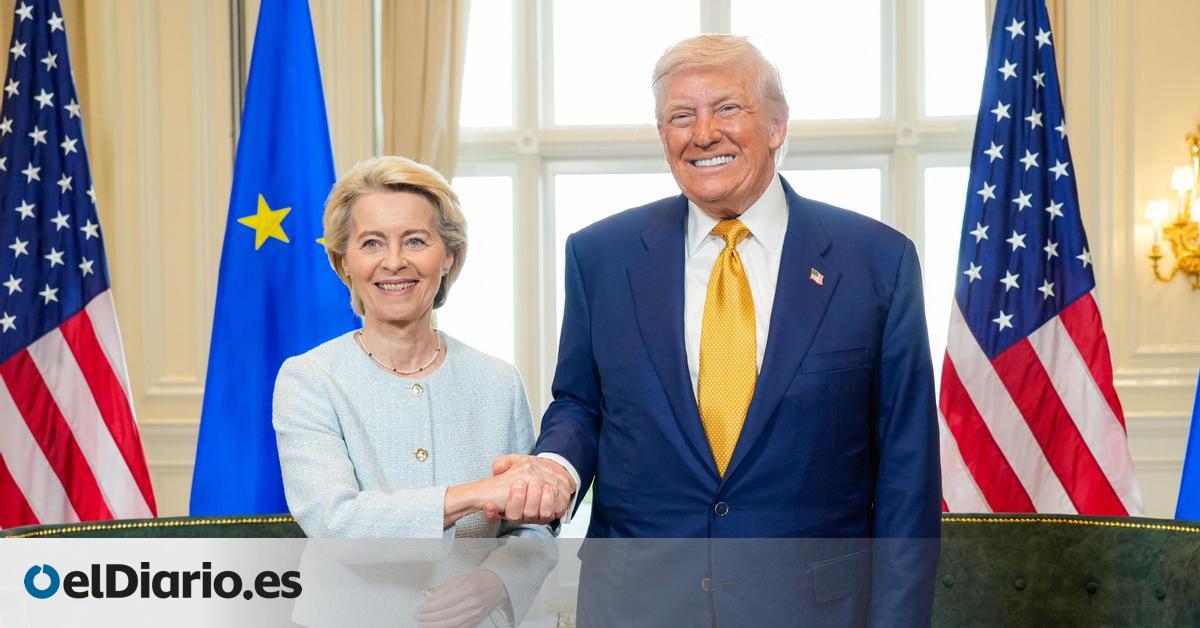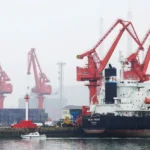
The European Union and the United States have agreed a written document with the terms of the political agreement that they achieved in July to avoid a tariff war, for which Washington will impose a 15% tariff to most European and Brussels imports undertakes to buy more military energy and material, they confirmed several community sources to EFE.
It is a “framework for a commercial transatlantic relationship and fair, balanced and mutually beneficial investment,” the commission said in a statement.
“The Joint Declaration details the new US tariff regime with respect to the EU, with a clear and integral tariff of 15% for the vast majority of EU exports, including strategic sectors such as the car, pharmaceutical products, semiconductors and wood. The sectors that are already subject to more favored nation tariffs (NMF) of 15% or superior will not be subject To additional tariffs, ”explains the European Commission.
“With regard to cars and their components, the US tariff limit of 15% will be applied simultaneously with the start by the EU of the tariff reduction procedures with respect to US products.” In this way, the 15% car tariffs reduction (now are 25%) will apply when the European bloc has taken measures to reduce those imposed by the United States.
The European Commissioner for Commerce, Maros Sefcovic, explained in a press conference that the EU objective is to present this month the proposal to eliminate tariffs on industrial goods in the United States and give preferential access to the European market to certain products of that country, so that the 15 % tariff to cars could be applied retroactively from August 1.
This was transmitted to the United States Secretary of Commerce, Howard Lutnick, who confirmed that in that case they would apply it retroactively since August 1, Sefcovic explained.
As of September 1, several products groups will benefit from a special regime, in which only the so -called NMF tariffs will be applied. “These include natural resources not available (such as cork), all aircraft and their components, generic pharmaceutical products and their ingredients, and chemical precursors.” In addition, “both parties agree to continue working ambitiously to expand this regime to other categories of products, a key result for the EU.”
The joint declaration, expected since the political agreement was closed in July, sets a maximum 15% tariff for the vast majority of EU assets that enter the United States, including cars, as well as semiconductors and pharmaceutical products in the event that Washington, which has a commercial investigation on their way, decides to impose tariffs.
The US has already applied this 15% tariff since the beginning of August to European goods that were subject to the so -called “reciprocal” tariffs, which until then were 10% and that Trump had threatened to raise up to 30%. However, the executive order approved by the White House left out of that application to European cars, which currently still have a 27.5%tariff. The joint statement states that this will be reduced from the “first day of the same month in which the EU introduces its legislative proposal” to reduce its tariffs.
In the case of steel and aluminum, to which Washington applies a 50%tariff, the document only indicates that they will consider “the possibility of cooperating” against excess capacity in their markets, included through a system of tariffs and quotas, although it does not require how that mechanism would work.
The Commission ensures that both parties recognize “the shared challenges, as well as the benefits of cooperation”, and “they intend to work to protect their economies of excess capacity in the steel and aluminum sectors, and to promote safe supply chains with each other, including a solution of tariff contingent for steel and aluminum exports of the EU, as well as for their derived products”.
“While the European Union maintains the conviction that high tariffs harm the world economy, the negotiated result avoids a harmful escalation and feels the foundations for continuous dialogue and the development of the transatlantic relationship, even in areas of shared strategic interest.”
Brussels emphasizes that “the transatlantic relationship is already the most valuable economic relationship in the world, with a value of 1.6 billion euros per year. The agreement safeguards this relationship and millions of jobs in the EU.”
In the words of the president of the European Commission, Ursula von der Leyen, “in a difficult situation, we have complied with our member states and our industry, and we have restored the clarity and coherence of transatlantic trade. This is not the end of the process; we continue to collaborate with the US to agree more international commercials, creating employment and prosperity in the EU ”.
The Commission recalls that the EU “aims to acquire American liquefied natural gas, oil and nuclear energy products” for a plan United, in a concerted effort to avoid the escape of technology to worrying destinations.
Also, the twenty -seven plan to “substantially increase” the purchases of military and defense equipment of the United States.
“Taking note”
The agreement indicates that “taking note of the US concerns related to the treatment of small and medium -sized US companies within the framework of the border adjustment mechanism of carbon emissions”, the European Commission “undertakes to work to provide additional flexibilities” to those already agreed.
In addition, the EU promises to “strive to ensure that the directive on due corporate diligence in matters of sustainability” and the directive on the presentation of corporate sustainability reports “do not impose undue restrictions on transatlantic trade.” “This includes efforts to reduce the administrative burden of companies, including SMEs, and propose changes in the requirement of a harmonized civil liability regime for breach of due diligence and in the obligations related to the climate transition. The European Union undertakes to work to address the concerns of the United States” regarding the imposition of this type “to companies of countries not belonging to the EU regulations high quality ”.
The ambassadors of the Member States before the European Union met this Thursday from 10:00, local time, so that the community executive explained the details of this joint declaration, which arrives almost a month after the president of the European Commission and the president of the USA, Donald Trump, arrived at a political agreement to avoid the tariff war in his encounter in a golf course of the magnate in Scotland last month.
Brussels defended that the political agreement, which was not well received in many community capitals, allowed to avoid a tariff war in which Trump had threatened to impose generalized tariffs of 30% on European imports and even superior in certain sectors.
During the negotiations, Trump himself has maintained uncertainty by threatening to place tariffs by 35% if the EU did not fulfill its part of the treatment.
Source: www.eldiario.es

